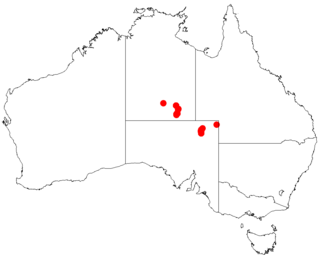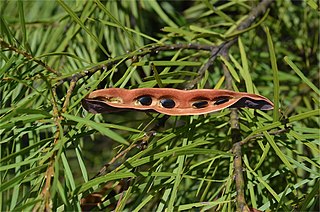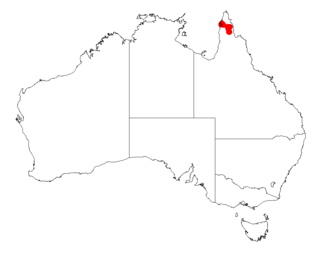
Acacia howittii, commonly known as sticky wattle or Howitt's wattle, is a tree species that is endemic to Victoria, Australia.

Acacia hispidula, known colloquially as little harsh acacia, rough-leaved acacia or rough hairy wattle, is a species of Acacia native to eastern Australia.

Acacia drepanocarpa is a shrub belonging to the genus Acacia and the subgenus Juliflorae native to northern Australia.

Acacia nyssophylla, commonly known as pin bush, wait a while and spine bush, is a shrub of the genus Acacia and the subgenus Plurinerves that is endemic to a large area of central and south-western and southern Australia.

Acacia calantha is a shrub belonging to the genus Acacia and the subgenus Phyllodineae native to Queensland in Australia.

Acacia attenuata is a shrub belonging to the genus Acacia and the subgenus Phyllodineae. It is native to an area in south eastern Queensland. It was listed as a vulnerable species in 2009 according to the Environment Protection and Biodiversity Conservation Act 1999.

Acacia crombiei, commonly known as pink gidgee, is a shrub belonging to the genus Acacia and the subgenus Phyllodineae that is native to central Queensland.
Acacia deuteroneura is a shrub belonging to the genus Acacia and the subgenus Phyllodineae that is endemic to Queensland. It was listed as vulnerable according to the Environment Protection and Biodiversity Conservation Act 1999 in 2008.

Acacia handonis, commonly known as Hando's wattle or Percy Grant wattle, is a shrub belonging to the genus Acacia and the subgenus Phyllodineae that is native to parts of north eastern Australia. In 2008 it was listed as vulnerable according to the Environment Protection and Biodiversity Conservation Act 1999.

Acacia pickardii, commonly known as Pickard's wattle or birds nest wattle, is a tree or shrub belonging to the genus Acacia and the subgenus Phyllodineae native to eastern Australia. It is listed as a vulnerable species according to Environment Protection and Biodiversity Conservation Act 1999.

Acacia rhetinocarpa, commonly known as neat wattle or resin wattle, is a shrub belonging to the genus Acacia and the subgenus Phyllodineae native to southern Australia. It was listed as vulnerable under the Environment Protection and Biodiversity Conservation Act 1999 in 2013.

Acacia ruppii, commonly known as Rupp's wattle, is a shrub belonging to the genus Acacia and the subgenus Phyllodineae native to eastern Australia. It is listed as endangered in the Environment Protection and Biodiversity Conservation Act 1999.
Acacia lauta, commonly known as Tara wattle, is a shrub of the genus Acacia and the subgenus Phyllodineae that is endemic to north eastern Australia. It is rated as being vulnerable according to the Environment Protection and Biodiversity Conservation Act 1999.

Acacia cretata is a shrub or tree belonging to the genus Acacia and the subgenus Juliflorae that is native to north eastern Australia.

Acacia curranii, also known as curly-bark wattle, is a shrub belonging to the genus Acacia and the subgenus Juliflorae that is native to north eastern Australia. It is listed as vulnerable under the Environment Protection and Biodiversity Conservation Act 1999.

Acacia macnuttiana, commonly known as McNutt's wattle, is a flowering plant in the family Fabaceae and is endemic to north-eastern New South Wales. It is a shrub with linear phyllodes, spherical heads of bright yellow flowers arranged in racemes in leaf axils and seeds usually in more or less straight, leathery pods.

Acacia praetermissa is a species of wattle native to a small area in the Northern Territory of Australia. It was listed as vulnerable in 2006 according to the Environment Protection and Biodiversity Conservation Act 1999.

Acacia solenota is a shrub belonging to the genus Acacia and the subgenus Juliflorae that is endemic to north eastern Australia. The species was listed as vulnerable under the Environment Protection and Biodiversity Conservation Act 1999 in 2008.

Acacia torulosa is a shrub or tree belonging to the genus Acacia and the subgenus Juliflorae that is native to north eastern Australia.

Acacia ommatosperma is a shrub of the genus Acacia and the subgenus Plurinerves that is endemic to an area of north western Australia.



















